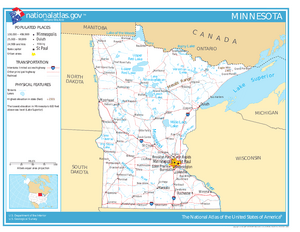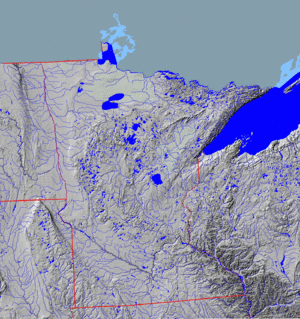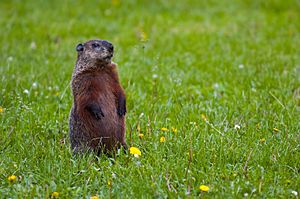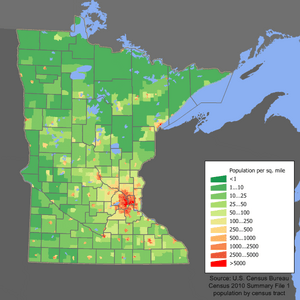Geography of Minnesota facts for kids
Minnesota is a large state in the northern part of the United States. It's known as "The Land of 10,000 Lakes" because it has so many! Minnesota is located in the Upper Midwest region of North America. It shares borders with Michigan and Wisconsin to the east, Iowa to the south, and South Dakota and North Dakota to the west. To the north, it borders the Canadian provinces of Manitoba and Ontario. Minnesota is the 12th largest state in the U.S., covering about 87,014 square miles (225,365 square kilometers).
Contents
Discovering Minnesota: The Land of 10,000 Lakes
Minnesota's Ancient Earth: Rocks and Glaciers
Minnesota is home to some of the oldest rocks on Earth! Some of these rocks are about 3.6 billion years old. That's almost as old as our planet itself. Long, long ago, about 2.7 billion years ago, hot lava flowed from cracks in the ocean floor. This created the Canadian Shield, a very old and strong part of the Earth's crust, in northeastern Minnesota. These ancient volcanic mountains and seas also formed the rich Iron Range in northern Minnesota.
How Glaciers Shaped the Land
Much more recently, huge sheets of ice, called glaciers, covered almost all of Minnesota. These glaciers were at least one kilometer thick! They moved across the land, carving out valleys and leaving behind hills and lakes. The last major glacier melted about 12,000 years ago. It left behind a thick layer of soil and rocks called glacial till across most of the state.
One special area in southeastern Minnesota, called the Driftless Zone, was not covered by these glaciers. This area has steep hills and streams that cut deep into the bedrock. About 13,000 years ago, a giant lake named Lake Agassiz formed in the northwest. When it drained, it carved out the valley of the Minnesota River. Its old lakebed became the very fertile Red River valley. Today, Minnesota is geologically quiet, meaning it rarely has earthquakes.
Minnesota has some interesting geographical features. The highest point is Eagle Mountain, which is 2,301 feet (701 meters) tall. The lowest point is the shore of Lake Superior, at 602 feet (183 meters). These two points are only about 13 miles (21 kilometers) apart!
In northeastern Minnesota, there's a unique spot where three major continental divides meet. This means that rain or snow falling there can flow in three different directions:
- South to the Gulf of Mexico via the Mississippi River.
- East to the Atlantic Ocean via the Saint Lawrence Seaway.
- North to the Arctic Ocean via the Hudson Bay watershed.
Minnesota truly lives up to its nickname, "The Land of 10,000 Lakes." There are actually 11,842 lakes that are ten acres or larger! The part of Lake Superior that is in Minnesota is the largest and deepest body of water in the state. It covers 962,700 acres (3,896 square kilometers) and is 1,290 feet (393 meters) deep. The state also has 6,564 natural rivers and streams, flowing for a total of 69,000 miles (111,000 kilometers). The famous Mississippi River starts its long journey from Lake Itasca in Minnesota. It flows for 680 miles (1,094 kilometers) through the state before reaching the Iowa border.
Amazing Animals and Plants of Minnesota
Minnesota is a special place where three major natural areas, called biomes, come together.
- In the southwest and west, you'll find wide open prairie grasslands.
- The southeast has the Big Woods, which are deciduous forests with trees that lose their leaves in the fall.
- The northern part of the state is covered by boreal forests, full of pine and spruce trees, mixed with birch and poplar.
Much of Minnesota's northern forests have been used for logging over the years. However, new trees are always growing, so about one-third of the state remains forested. Special areas like the Chippewa National Forest and the Superior National Forest protect some of the oldest trees. The Boundary Waters Canoe Area Wilderness in the Superior National Forest has about 400,000 acres (1,600 square kilometers) of untouched forest.
Wildlife: From Wolves to Eagles
Even though some animals like the pine marten, elk, and bison have been affected by habitat changes, many others are thriving. You can find lots of whitetail deer and bobcats. Minnesota has the largest population of timber wolves in the U.S. outside of Alaska! It's also home to healthy numbers of black bears and moose.
Minnesota is a great place for birdwatching because it's on the Mississippi Flyway. This is a major route for migratory waterfowl like geese and ducks. You can also spot game birds such as grouse, pheasants, and turkeys. Many amazing birds of prey live here, including the majestic bald eagle, red-tailed hawk, and snowy owl. The lakes are full of popular sport fish like walleye, bass, muskellunge, and northern pike. In the southeastern streams, you can find different kinds of trout.
Minnesota's Weather: Hot Summers and Cold Winters

Minnesota has a continental climate, which means it has big changes in temperature. Winters are very cold, and summers can be quite hot. The difference between the highest and lowest recorded temperatures is a huge 174°F (97°C)!
The state experiences all kinds of weather. This includes rain, snow, hail, and powerful blizzards. Sometimes, polar fronts bring very cold air. In warmer months, there can be tornadoes, strong thunderstorms, and fast winds called derechos. The growing season for plants varies from 90 days in the northern Iron Range to 160 days near the Mississippi River in the southeast. Average temperatures range from 36°F to 49°F (2°C to 9°C). Minnesota gets between 19 to 35 inches (48 to 89 centimeters) of precipitation each year, depending on the location.
Exploring Minnesota's Parks and Wild Areas
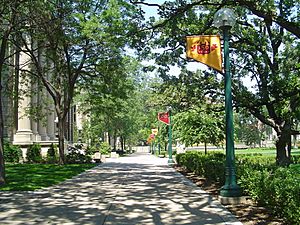
Minnesota has many beautiful natural areas, including parks and wilderness. The very first state park, Itasca State Park, was created in 1891. This is a special place because it's where the mighty Mississippi River begins!
Today, Minnesota has 72 state parks and recreation areas. It also has 58 state forests that cover about four million acres (16,000 square kilometers). These areas are managed by the Minnesota Department of Natural Resources to protect wildlife and nature.
The state is also home to two large national forests: the Chippewa National Forest and the Superior National Forest, which together cover 5.5 million acres (22,000 square kilometers). Inside the Superior National Forest is the amazing Boundary Waters Canoe Area Wilderness. This wilderness area is over a million acres (4,000 square kilometers) and has a thousand lakes, perfect for canoeing and exploring. To its west, you'll find Voyageurs National Park, which is Minnesota's only national park.
Different Parts of Minnesota: Regions to Explore
Minnesota can be thought of as having two main parts: the Minneapolis–Saint Paul metropolitan area, often called "The Cities," and "Greater Minnesota," which is everything else.
The Twin Cities: Minneapolis and Saint Paul
The Minneapolis-St. Paul area is where most people live. It includes eleven counties in Minnesota, centered around Minneapolis, the state's largest city, and Saint Paul, the state capital. About three out of every five Minnesotans live in this busy urban area.
Beyond the Cities: Greater Minnesota
Greater Minnesota is less crowded and has a lot of natural beauty. It's very diverse, with farmlands in the south and west, many lakes in the central part, and thick forests in the north. About 40% of Minnesotans live here. Some of the larger cities in Greater Minnesota include Duluth, Rochester, Moorhead, St. Cloud, Mankato, and Winona.
Here are some of Minnesota's unique geographic regions:
- The Arrowhead Region is in the far northeastern part of the state. It gets its name from its shape, which looks like an arrowhead pointing north of Lake Superior. This region includes the Iron Range, famous for its iron mines, and the beautiful North Shore along Lake Superior.
- Central Minnesota is generally the area influenced by the city of St. Cloud. It's known for its many lakes.
- The Northwest Angle is a small, isolated piece of Minnesota that is north of the 49th parallel, surrounded by Canada and Lake of the Woods.
- Southeastern Minnesota is often called the "Bluff Country" or Driftless Area. It has scenic bluffs and valleys carved by rivers like the Mississippi, Whitewater, Zumbro, and Root. Rochester is its main city.
- Southwestern Minnesota includes the Buffalo Ridge, an area with higher elevation and strong winds, making it a good place for wind power.
- The Red River Valley is a very fertile agricultural area in the northwestern part of the state, known for its rich soil from the ancient Lake Agassiz.


